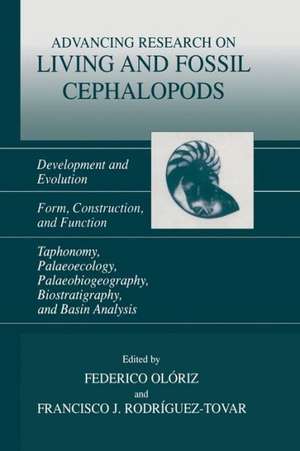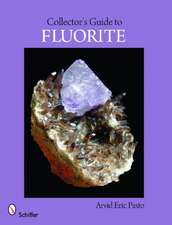Advancing Research on Living and Fossil Cephalopods: Development and Evolution Form, Construction, and Function Taphonomy, Palaeoecology, Palaeobiogeography, Biostratigraphy, and Basin Analysis
Editat de Federico Olóriz, Francisco J. Rodríguez-Tovaren Limba Engleză Paperback – 7 noi 2012
With its unparalleled combination of first-rate contributions on living and fossil cephalopods, this book provides researchers and advanced students in paleontology, invertebrate zoology, evolutionary biology, and allied disciplines with a trove of recent data and authoritative interpretations that will immeasurably benefit their own studies.
| Toate formatele și edițiile | Preț | Express |
|---|---|---|
| Paperback (1) | 1229.73 lei 6-8 săpt. | |
| Springer Us – 7 noi 2012 | 1229.73 lei 6-8 săpt. | |
| Hardback (1) | 1244.08 lei 6-8 săpt. | |
| Springer Us – 31 mar 1999 | 1244.08 lei 6-8 săpt. |
Preț: 1229.73 lei
Preț vechi: 1499.66 lei
-18% Nou
Puncte Express: 1845
Preț estimativ în valută:
235.33€ • 245.100$ • 198.86£
235.33€ • 245.100$ • 198.86£
Carte tipărită la comandă
Livrare economică 06-20 martie
Preluare comenzi: 021 569.72.76
Specificații
ISBN-13: 9781461371939
ISBN-10: 1461371937
Pagini: 572
Ilustrații: XVI, 550 p.
Dimensiuni: 155 x 235 x 30 mm
Greutate: 0.79 kg
Ediția:Softcover reprint of the original 1st ed. 1999
Editura: Springer Us
Colecția Springer
Locul publicării:New York, NY, United States
ISBN-10: 1461371937
Pagini: 572
Ilustrații: XVI, 550 p.
Dimensiuni: 155 x 235 x 30 mm
Greutate: 0.79 kg
Ediția:Softcover reprint of the original 1st ed. 1999
Editura: Springer Us
Colecția Springer
Locul publicării:New York, NY, United States
Public țintă
ResearchCuprins
I: Development and Evolution.- 1. Cephalopod Development and Evolution: Biological Insight into Ontogenesis as a Guide to Paleomorphology.- 2. Hatching of Nautilus macromphalus in the Toba Aquarium, Japan.- 3. Comparative Analysis of Some Morphometric Characters in Two Sepiolids: Sepietta neglecta (Naef, 1916) and Sepietta oweniana (Orbigny, 1840).- 4. Embryonic Development of Primitive Ammonoids and the Monophyly of the Ammonoidea.- 5. A Late Carboniferous Spirulid Coleoid from the Southern Mid-Continent (USA): Shell Wall infrastructure and Evolutionary Implications.- 6. Plasticity of Developmental Timing as the Underlying Cause of High Speciation Rates in Ammonoids: An Example from the Cenomanian Western Interior Seaway of North America.- 7. Pathologic Gigantism in Middle Carboniferous Cephalopods, Southern Midcontinent, United States.- 8. Aalenian Tmetoceras (Ammonoidea) from Iberia: Taxonomy, Habitats, and Evolution.- 9. Evolution of the Family Sibiritidae and Detailed Biostratigraphy of the Siberian Upper Olenekian (Triassic).- 10. The Genus Cadochamoussetia in the Phylogeny of the Jurassic Cardioceratidae (Ammonoidea).- 11. A Review of Volkhovian and Kundan (Arenig-Llanvirn) Nautiloids from Sweden.- 12. The Xiphoteuthididae Bather, 1892 (Aulacocerida, Coleoidea): An Outline Classification.- II: Form, Construction, and Function.- 13. Ultrastructural Studies on the Epidermis of Adult Octopus vulgaris Cuvier, 1797.- 14. Comparative Immunohistochemical and Immunocytochemical Investigations on the Location of Haemocyanin Synthesis in Dibranchiate and Tetrabranchiate Cephalopods (Sepia and Nautilus).- 15. Ultrastructural Studies of the Suckers of Newly Hatched Eledone moschata and Octopus vulgaris (Mollusca; Cephalopoda).- 16. Conch Ultrastructure and Septal Neck Ontogeny of the Belemnite Conobelus (Duvaliidae) from the Valanginian of the Crimea (Black Sea).- 17. Aggregation of Aragonite in the Outer Prismatic Layer of Mesozoic Ammonoids.- 18. Internal Features of the Embryonic Shells of Late Carboniferous Goniatitina.- 19. Early Ontogeny of the Siphuncle and Shell in the Early Carboniferous Rayonnoceras (Actinocerida) from Arkansas, USA.- 20. The Use of Landmarks to Describe Ammonite Shape: Examples from the Harpoceratinae.- 21. Recent Advances in Morphometric Approaches to Covariation of Shell Features and the Complexity of Suture Lines in Late Jurassic Ammonites, with Reference to the Major Environments Colonized.- 22. Morphological Diversity of Ammonoids from the Lower Namurian of Central Asia.- 23. Whorl Width in the Body Chamber of Ammonites as a Sign of Dimorphism.- III: Taphonomy, Palaeoecology, Palaeobiogeography, Biostratigraphy, and Basin Analysis.- 24. Rollmarks of Soft Parts and a Possible Crop Content of Late Cretaceous Ammonites from the Slovenian Karst.- 25. Possible Cephalopod Reproductive Mass Mortality Reflected by Middle Carboniferous Assemblages, Arkansas, Southern United States.- 26. Silurian Cephalopod Limestone Facies in the Carnic Alps (Rauchkofel Boden Section, Austria): Taphonomy of the Nautiloid Fauna.- 27. Nautiloid Paleobathymetry from the Silurian &3x2018;Orthoceras Limestone’ Facies of SW Sardinia, Italy.- 28. Aalenian Tmetoceras (Ammonoidea) from Iberia: Taphonomy and Palaeobiogeography.- 29. Belemnite Distribution Patterns: Implications of New Data from Argentina.- 30. The Deshayesites Kazansky, 1914 (Ammonoidea) Representatives in Romania, a Link between the West-European and Caspian Assemblages of this Genus.- 31. Ammonite Biostratigraphy and Correlations in the Upper Jurassic-Lowermost CretaceousLa Caja Formation of North-Central Mexico (Sierra de Catorce, San Luis Potosi).- 32. Silurian Cephalopod Limestone Biofacies from Eastern Siberia: Fauna, Age, and Environments.- 33. Biostratigraphic Distribution of Lower Carboniferous Ammonoids in Northern Russia.- 34. Stratigraphic Position of Valanginites, Lissonia, and Acantholissonia in the Lower Valanginian (Lower Cretaceous) Ammonite Sequence of the Neuquen Basin, Argentina.




